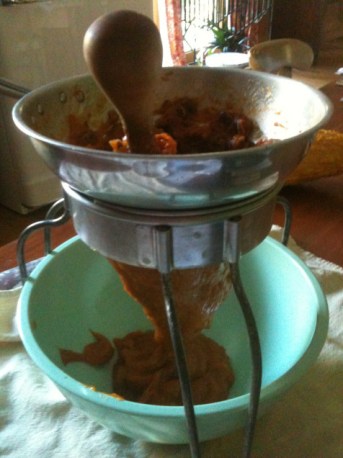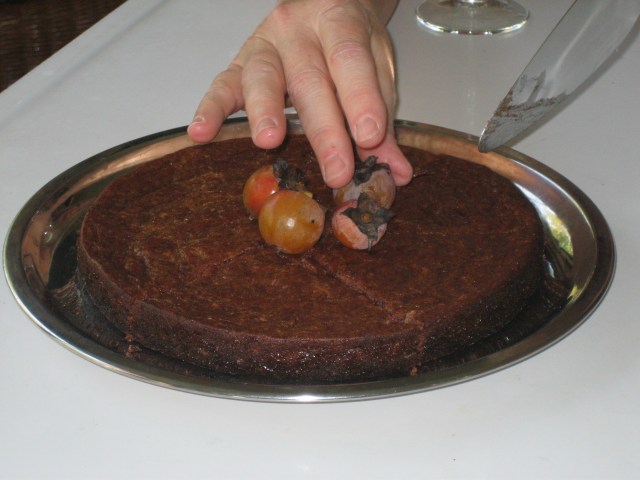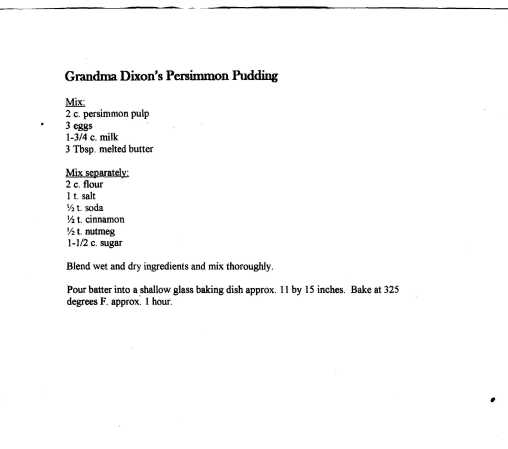![IMG_2262[1]](https://adapter.pub/wp-content/uploads/2023/12/20231212055337-6577f561c8ea7.jpg)
As woodworkers, we tend to think about trees most often in the context of wood. But a living tree is habitat, safe perch, shady spot, daily carbon dioxide sink, and more.
Trees also bear fruit. Until I moved to Indiana, persimmons were novelties: fat juicy globes with exotic names such as Fuyu and Hachiya. Then, one October, a boyfriend proposed a weekend paddle on Lake Monroe (yes, he’d made his own canoe) to a spot rich with persimmons. We filled a couple of shopping bags with squishy fruit and paddled back to the truck. He showed me how to make pulp and shared his grandmother’s recipe for pudding.

When we pulled the glass dish out of the oven, the kitchen filled with sweet, spicy steam. We let the pudding sit a while to firm up while we whipped some cream. Slice, serve, dollop. Heaven.

Much smaller than their Oriental cousins, our native persimmons are packed with nutrients: 127 kcal per 100 grams of raw fruit (compared to 70 kcal for the same amount of Japanese persimmon, Diospyros Kaki), 33.5 grams of carbohydrate (compared to 18.59), 0.8 grams of protein (versus 0.58), as well as higher than the Japanese persimmon in fat, calcium, and iron. I offer this comparison not as an exercise in nationalism, but to help explain why the peoples native to this land considered putchamin an important food.

+++
A couple of years after my first taste of persimmon pudding I was looking for an affordable property where I could have a workshop. The first place I visited fit the bill and came with a bonus: an old persimmon tree on the front lawn and a couple more on the fence line.
Fast-forward fourteen years. After feeding many a deer (and two of my dogs) and giving us fruit for countless puddings, the old tree in our front yard finally gave up the ghost last winter. We had plenty of advance notice: fewer leaves each spring, more limbs dropped per thunderstorm. Of course it’s not really gone: Persimmons spread through their roots to form groves. Several daughter trees are growing to maturity in the garden.
![IMG_2263[1]](https://adapter.pub/wp-content/uploads/2023/12/20231212055344-6577f56839a2a.jpg)
A large dead tree in the front yard is hardly attractive. “Can we please cut it down?” I asked my husband last spring. I wasn’t asking for permission; he’s the one who uses a chainsaw. I’ll use industrial shop equipment any day, but chainsaws terrify me. “No,” he said; “it offers wild birds refuge from Louis [the shop cat].” Spring turned to summer, and concern for the birds’ safety turned into “Taking that tree down is going to be a huge project. Do you have any idea how much work it’s going to be, cleaning up those limbs?” Clearly not a job for the itchy, sweaty months. Now that fall is here (if tentatively), we’ll take it down and give some of the wood to our friend Max Monts to turn into bowls, because as many readers will already be aware, persimmon is related to ebony.–Nancy Hiller, author of Making Things Work
+++
Here’s that recipe.
